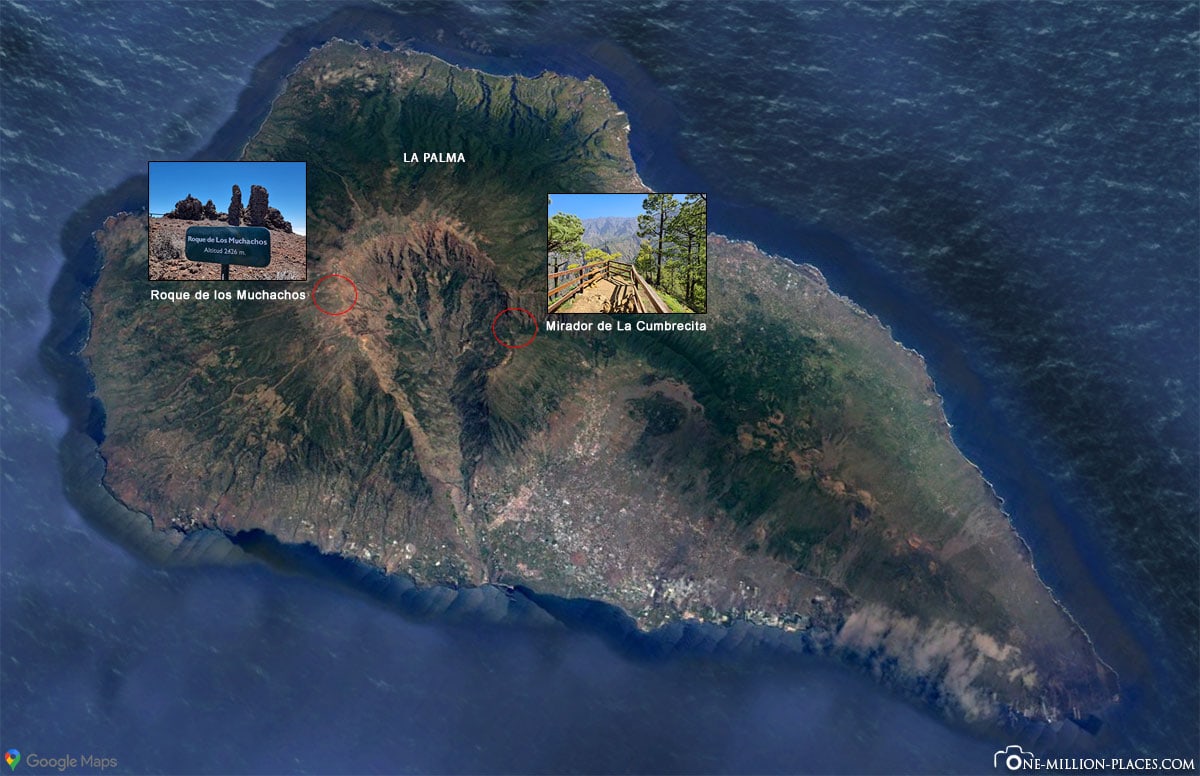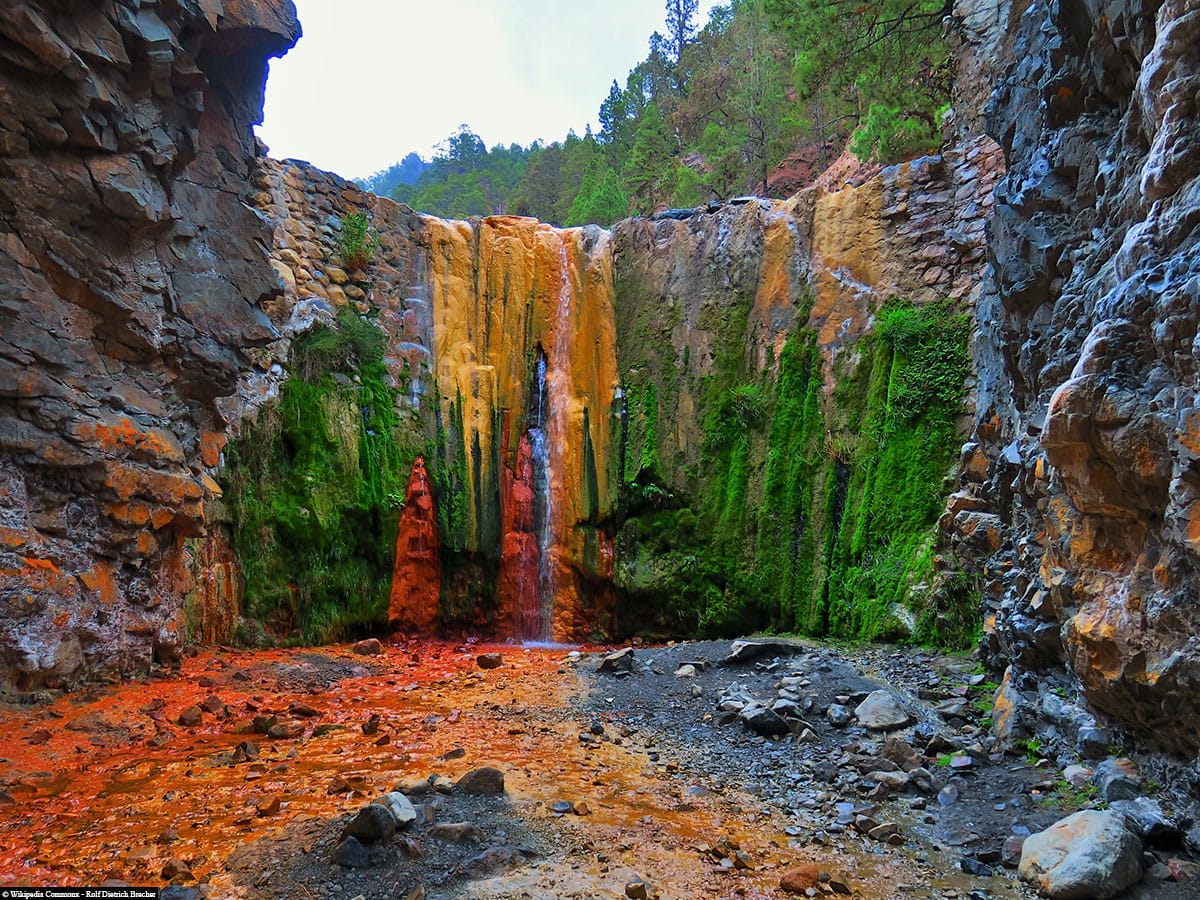One of the biggest attractions and most beautiful sights of La Palma are the Caldera de Taburiente National Park, located in the center of the island and the Roque de Los Muchachos. On two days we visited two different viewpoints, which offer a breathtaking view into the caldera as well as the surrounding nature.

Table of contents
The Caldera de Taburiente National Park
The Caldera de Taburiente National Park is located in the center of La Palma and is one of the most important sights of the island with its crater-like depression open to the west. The lowest point of the crater is at 430 meters above sea level and the highest point is Roque de los Muchachos at 2,426 meters above sea level. With a diameter of about 9 kilometers and a circumference of almost 30 kilometers, the Caldera de Taburiente is considered one of the largest craters in the world. Thanks to the fascinating landscape and its scientific importance, the area was declared a national park in 1954. Here visitors can expect countless rock formations, vast pine forests, deep & narrow gorges as well as picturesque streams, springs and waterfalls.
The Mirador de La Cumbrecita
The Mirador de La Cumbrecita is located at an altitude of 1,312 meters and is one of two access points to the Caldera de Taburiente National Park. The viewpoint is primarily used to take a first look into the erosion crater. From the Mirador de La Cumbrecita several hiking trails lead through the national park.
Visitor Center & Parking
Since 2007, access to the Mirador de La Cumbrecita in the Caldera de Taburiente National Park has been regulated, because the parking lot was regularly overcrowded and the access roads were partially blocked as a result. Those who wish to visit this viewpoint or take a hike and park in the corresponding parking lot must make a free parking reservation in advance through the official website. This can be done at the earliest one month before the corresponding visit day and at the latest on the same day. There are only 20 parking spaces available in total, so you should be quick.
By the way, on the LP 3 road is the Caldera de Taburiente Visitor Center, where there is a permanent exhibition on the Caldera de Taburiente National Park. In addition, one learns interesting facts about the formation of the caldera and about flora and fauna in the national park.
Mirador Lomo de las Chozas
From the parking lot we took a short hike of about 1 kilometer to the beautiful viewpoint Lomo de las Chozas. The path is basically suitable for strollers, but we had to carry the car in two places due to some debris. Along the way, we kept having great views of the surrounding area. Arriving at the viewpoint, we had a beautiful view into the huge crater cauldron, which has a circumference of about 30 kilometers, a diameter of about 8 kilometers and a depth of about 1,700 meters. These dimensions are totally impressive!
View of the cloud waterfall over Cumbre Nueva
Another sight that can be admired wonderfully from the Mirador La Cumbrecita or also from the Visitor Center is the Cloud Waterfall over the Cumbre Nueva. At an altitude of 1,450 meters, trade wind clouds coming from the east roll over the ridge and dissipate on the west side. An insanely interesting natural spectacle!
The Roque de los Muchachos
Exploring Roque de los Muchachos in the Caldera de Taburiente National Park is one of the highlights of La Palma, because it is the highest mountain on the island.
Access via the LP-4
To get to the highest mountain of La Palma, we drove along the access road LP-4 from the east. Since this is very curvy and you overcome a lot of altitude in a short time, we stopped every now and then and took a break because of our little daughter. So the ride to the top took a little longer, but it was more important to us that the ascent went without incident because of the ear pressure. On the way we discovered a very photogenic plant: the viper’s bugloss. This particular endemic plant is found only in subalpine regions of Tenerife and La Palma. With our car we went through the cloud cover higher and higher… until the blue sky and the sun appeared.
Parking lot at Roque de los Muchachos
Arrived at the top, we had the great fortune to find a parking space directly. The parking spaces at the top are free of charge, and you don’t need to make a reservation in advance… but there are only about 25 parking spaces. But since there is always a coming and going, there was actually always a gap free. From the parking lot you already have fantastic views of the surrounding area. But it is worth going a little further, because there are other viewpoints on the summit.
Viewpoints at Roque de los Muchachos
From the parking lot, a small path leads to two other viewpoints. First, you pass a group of smaller rock pillars that have given the peak its name – translated into German,“Roque de los Muchachos” means “Rock of the Boys or Younglings”. All along the way, breathtaking views of the surrounding area and cloud cover open up to us on all sides. On a clear day you can even see the neighboring islands of El Hierro, Tenerife and La Gomera. We definitely saw the Teide, Tenerife’s highest mountain, with its 3,715 meters height, flashing through the cloud cover. Being above the clouds and seeing the passing clouds is always an indescribable feeling.
It took us about an hour to visit the two viewing platforms, including a few breaks. Even though the sun was shining really hard, the temperature was still very cold at 8 degrees. A sunscreen and a jacket should therefore be best with you 😉
Roque de los Muchachos Observatory
On Roque de los Muchachos, at an altitude of between 2,350 and 2,400 meters, is a collection of astrophysical observatories opened in 1985 and collectively referred to as the “Roque de los Muchachos Observatory.” Together with the Teide Observatory on Tenerife, it forms the European Northern Observatory, which involves about 170 research institutes and 31 countries.
The Roque de los Muchachos Observatory is considered one of the largest observatories in the world. Thanks to the deep dark and cloudless night sky, the almost particle-free air layer at an altitude of 2,400 meters, and the climatic conditions on La Palma, it is one of the most suitable places in the world for observing the celestial bodies throughout the year. Quite interestingly, we find that La Palma was certified in 2012 as the world’s first UNESCO Starlight Reserve, encompassing the entire island as well as parts of the surrounding Atlantic Ocean and the neighboring Canary Island of Tenerife. In such a light protection area, nocturnal darkness is considered a protected good and is already protected from very minor light pollution.
The Visitor Centre
About 5 kilometers from the parking lot of Roque de los Muchachos in the Caldera de Taburiente National Park is the newly opened, very modern visitor center, the Centro de Visitantes del Roque de los Muchachos. When we were there in April 2022, the visitor center was already open, but still somewhat unfinished in parts. For this reason, we have not yet had to pay an entrance fee. Since June 1, 2022, the entrance fee is 15 EUR per person. The aim of the Visitor Center is to make known the importance of astronomy on the island of La Palma. In different rooms, you will learn why the Canary Islands were chosen to host the most important telescopes in the world. In addition, you dive into the depths of the cosmos and have the opportunity to discover every corner of science and our universe. The museum is very attractively designed and definitely makes you want to delve deeper into the subject.
The Cascada de Los Colores
Another way to explore the Caldera de Taburiente is to hike inside the crater. There are many hiking trails here that wind through the countryside. One of the highlights are certainly the Cascada de Los Colores. Unfortunately, we didn’t visit these colorful waterfalls because the hike would have been too long and too difficult for us with our little daughter. But if you have enough endurance, stamina and time, you should not miss a visit to this natural spectacle in the Caldera de Taburiente National Park.
Overall, we really enjoyed the Caldera de Taburiente and our trip to Roque de Los Muchachos. These two viewpoints are rightly among the highlights of the Canary Island of La Palma.


